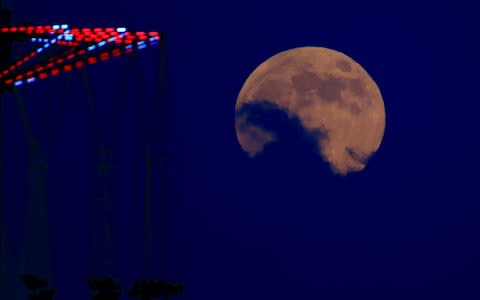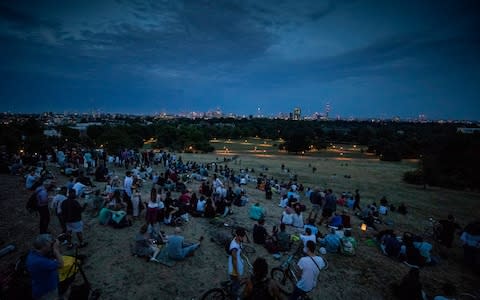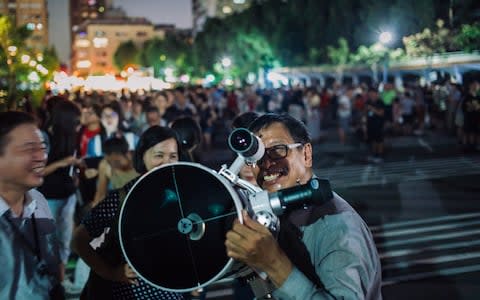UK blood moon: World looks to the skies for rare lunar eclipse

Curiosity and awe have greeted a complete lunar eclipse, the longest one of this century and visible across much of the world.
The so-called "blood moon," when it turns a deep red, was visible at different times in Australia, Africa, Asia, Europe and South America when the sun, Earth and moon lined up perfectly, casting Earth's shadow on the moon.
The total eclipse lasted 1 hour and 43 minutes, with the entire event lasting closer to four hours.
Rio de Janeiro's spectators cheered when the blood moon emerged from the fog. Hundreds of people watched at a fort overlooking the iconic Copacabana beach and Sugarloaf Mountain. The local planetarium set up telescopes for astrology fans.
"These telescopes are fantastic. It's one thing to see pictures of the planets in a book and another to see it in real life," said Ana Selma Ferreira, a 46-year old lawyer who brought her children to the spectacle.
The blood moon: a rare lunar eclipse, in pictures
Across Africa people turned to the sky, watching the reddish shadow slide up the moon's surface.
In Somalia, some hurried to mosques for special prayers. In South Sudan, some dared to take photos in a war-torn country where using a camera in public is discouraged.
In Ethiopia's capital, Addis Ababa, people at an open-air restaurant admired a rare clear view during the rainy season, comparing a live NASA webcast to what they saw above. Then clouds rolled in.
"Dem yelebesech chereka," some murmured - Amharic for "blood moon."
In a special treat, Mars is also at its closest approach to Earth this week since 2003, making it appear bigger and brighter.

Excited skywatchers on social media shared photos of the bright planet just to the right of the moon.
North America missed out on Friday's lunar eclipse but can look forward to the next one on Jan. 21, 2019, according to NASA.
the super blood moon rising behind the temple of poseidon, athens, greece. pic.twitter.com/hN7eEusA9F
— f thot fitzgerald (@dracomallfoys) July 27, 2018
Cloud puts dampener on UK spectable
Those in Britain hoping to glimpse the rare eclipse were left disappointed as clouds largely obscured the celestial phenomenon.
After weeks of uninterrupted sunshine and cloudless skies, thunderstorms swept across swathes of the UK on Friday, veiling what was said to be the longest celestial event in the 21st century.
Groups of hopefuls camped out on Primrose Hill were treated to dark skies with the only light coming from London's skyline.

The lunar eclipse, which was estimated to last around 103 minutes, saw the "total" phase end at around 10.13pm, with the moon passing through the Earth's darkest shadow and take on a red sheen.
But a blanket of grey spoiled any chance of a glimpse for people in Hampshire and Wiltshire in the south and south west, to Hull in east Yorkshire, Liverpool in the north west and Dublin in Ireland.
Eager observers who had assembled on cliffs and beaches in the English county of Dorset were left in the dark due to an overcast sky.
"It's disappointing," Tish Adams, 67, told reporters. "I took a few photos but there was nothing but a streak of pink in the sky."
The next total lunar eclipse in the UK will take place on January 19 2019.
Social media users were quick to post sarcastic tweets about how great their view of the celestial event was, with many bemoaning the fact that skies had been clear for weeks only to cloud up on Friday.
Probably the best shot of the #BloodMoon you'll ever see. The UK is fantastic! pic.twitter.com/nZ9A6OcNoP
— Charles (@nerdosed) July 27, 2018
Why, UK, WHY?
We're promised a blood moon and the longest eclipse for 100 years or something like that and you choose tonight to be cloudy for the first time in FOREVER! pic.twitter.com/5X6lE5uPwD— Geozaki��️�� (@Geozaki4) July 27, 2018
What caused the 'red moon'?
A total lunar eclipse happens when Earth takes position in a straight line between the moon and sun, blotting out the direct sunlight that normally makes our satellite glow whitish-yellow.
The moon travels to a similar position every month, but the tilt of its orbit means it normally passes above or below the Earth's shadow - so most months we have a full moon without an eclipse.
What makes this event special is the unusually large and bright position of Mars, a mere 57.7 million kilometres (35.9 million miles) from Earth on its elliptical orbit around the sun.

"We have a rare and interesting conjunction of phenomena," Pascal Descamps, an astronomer with the Paris Observatory, told reporters.
When the three celestial bodies are perfectly lined up, the Earth's atmosphere scatters blue light from the sun while refracting or bending red light onto the moon, usually giving it a rosy blush.
This is what gives the phenomenon the name "blood moon".
Blood Moon Myths

